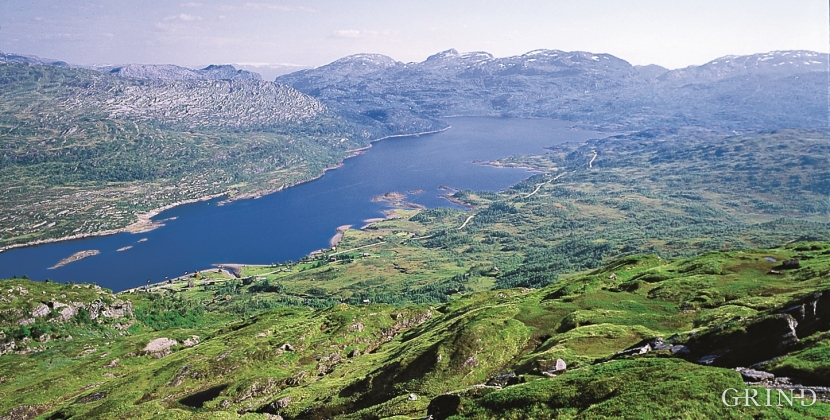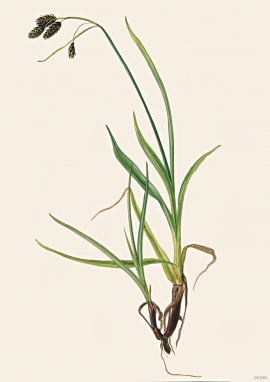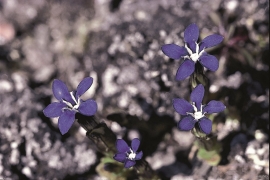Published: 12.08.2015 | Author: Haakon Fossen, Bjørn Moe
From Hamlagrøhornet one sees a division between the fertile phyllite and the naked Precambrian basement rock types in the landscape. View toward south. Mt. Øyaseteggi (back left) is built up of granite and is nearly barren of vegetation. (Svein Nord)
THE LIFE-GIVING BEDROCK”
The type of underlying rock can be decisive for how many different types of plants are found in an area. In the area around Hamlagrø-lake the diversity is especially obvious. The geological conditions change much here within a short distance.
Between naked and grey bedrock, lies the Hamlagrø area, lush and green, with fields and mountain farms. The basis for the fertile lushness is a belt of phyllite, which also contains mica schist. The phyllite belt, which crosses the westerly part of Hamlagrøvvatnet Lake, separates the harder Precambrian basement rocks of the Bergsdals Complex. If we follow the highway from Osen along the water, we meet the phyllite belt at Grønestad. The phyllite zone is a couple of kilometres wide, but narrows toward the southwest, at the foot of Mt. Fuglafjellet. Mt. Fuglafjellet and most of the other high mountaintops in the area are made of harder rock types, such as quartzite and granite.
From the many lookout points in the area it is easy to see the sharp division between the fertile phyllite and the naked Precambrian basement rock types.
A rock type consists of minerals with chemical compositions that are vitally important for the plants. It is not sufficient that one rock type contains the needed nutrients. The minerals can be so bound to the rock that the plants cannot utilize the nutrients they need. It is just as important, therefore, that the plant nutrients are able to be dissolved from the rock type. It is first when weathering has ensured that the nutrients get dissolved into the groundwater, that the that the plants can take them up through their roots.
Which rock types are favourable for the plants? Phyllite and mica schist contain large amounts of mica minerals and often some calcium. Mica is a flake mineral, with weak bonds across its flaky structure. The flakes are therefore easily split off, and weather to give abundant nutrients in the groundwater. Granite and especially quartzite contain much quartz. This mineral does not contain much plant nourishment. Therefore it is not surprising that there are large contrasts in the vegetation when the nutrient-rich and nutrient-poor rock types lay side by side. Since quartz-rich and hard thrust sheets make up most of the highest elevations in many mountainous areas, there is very little that grows on the tops. A number of mountain plants are completely dependent on the phyllite, which is often exposed a bit lower in the terrain and in smaller areas connected to steep mountains, ravines and canyons.
On Mt. Hamlagrøhornet the phyllite reaches up to 1080 m a.s.l., and much nutrient-rich residual soil has been formed even at great height. In this beautiful walking terrain there is also an extra calcium-rich part of the phyllite. Because of this, Hamlagrøhornet has a species rich flora, including many quite finicky plants. Strangely enough, a body of quartzite has strayed into the phyllite belt, and it forms the naked and distinctive top, Mt. Løva.
Hamlagrøvatnet
The dry banks along Lake Hamlagrøvatnet are a result of developments in the Bergdal water system. The water is tapped 17 metres down in winter in the eastern part and 27 metres in the western part. These "nature controllers" influence some people's experience of the nature here. It is also a reminder that our energy-demanding lifestyle has consequences, also in the mountains.
- Fossen, H. 1993. Structural evolution of the Bergsdalen Nappes, Southwest Norway. Norges Geologiske Undersøkelse 424:23–50.
- Kvale, A. Petrologic and structural studies in the Bergsdalen quadrangle, western Norway. Bergen Museums Årbok 1946–47,Naturvit.rekke,1.
- Moe, B. 1985. Fjellflora og –vegetasjon i midtre Hordaland. Analyse av en botanisk øst-vest-gradient. Hovedfagsoppg. UiB. Botanisk institutt.
- Moe, B. 1995. Studies of the alpine flora along an east-west gradient in central Western Norway. Nordic Journal of Botany 15:77–89.







